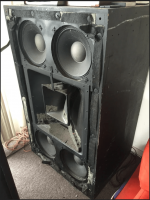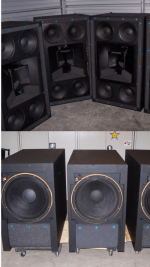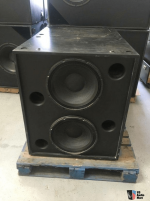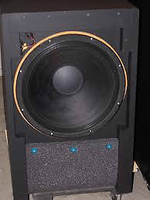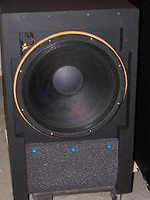For playing or practice around the house
sub will work fine.
far as a band situation
with a drummer in the studio
or small bar, outdoor stage etc
etc.
not enough efficiency.
I get it though I listen to EDM to Dub to Jazz or metal.
Sub bass in the car was always fun
sub will work fine.
far as a band situation
with a drummer in the studio
or small bar, outdoor stage etc
etc.
not enough efficiency.
I get it though I listen to EDM to Dub to Jazz or metal.
Sub bass in the car was always fun
Lowest fret on a 4-string is about 41 Hz, on a 5-string with a low B, it's about 31 Hz. Most of the output is 1 - 2 octaves higher, so if the speaker reproduces 82 Hz / 62 Hz well, you get most of the sound of the bass.When the internal filters and boost is bypassed, it does the lowest fret with an authority that music shop amp cab combos can only dream of.
Personally I don't miss the fundamental, and prefer having it filtered out. But that's obviously subjective, and evidently, you do like having as much of the fundamental frequency as you can.
It looks like the little 7" driver in this Logitech sub peaks around 65 Hz, while the enclosure port is tuned to around 45 Hz. This will cope well with the lowest note from a 4-string bass in standard tuning, as long as you don't ask for too much SPL.
If you can measure frequency response of your sub with the electronic filters bypassed, you will have a better idea what exactly it is that you like so much. (It always comes down to frequency response.)I feel that this combination of driver, port, box and amp somehow has come together in a very optimum fashion.
-Gnobuddy
There are two things (physics) that are very different about trying to make deep bass in a car, compared to a room, or worse, outdoors.I didn't realise that car subs are made for car cabins.
1) The first thing is that the air volume inside a car is very small; 100 cubic feet is typical, and that's 2.832 cubic metres.
For a subwoofer in a car, if we assume, say, a 12" woofer with a 1" stroke, we can calculate the resulting volume change in the car interior (it works out to 0.001853 cubic metres).
Way back in school, we learned that pressure x volume = constant for a gas. If you halve the volume, you double the pressure. If you change the volume by 1%, you change the pressure by 1%, too.
Now that we know we have a volume change of 0.001853 cubic metres, starting with an initial volume of 2.832 cubic metres, we can calculate the resulting pressure change. Once we know the pressure change, we can convert that to SPL in decibels.
I did the math, and the result of this quick and dirty approximate calculation, is that a 12" sub, with a 1" stroke, in a car with an interior volume of 100 cubic feet, should produce around 130 dB (!!).
Now, this quick and dirty calculation is based on the assumption that the pressure is the same everywhere in the volume of air being considered. Since the dimensions of the interior of a car are much smaller than a half-wavelength of deep bass sound waves, this is a reasonable assumption for frequencies 50 Hz and below.
From the reasoning above, it should be clear that if the car's interior volume was bigger, you'd get a smaller pressure change - meaning, less SPL. Put the same sub into a schoolbus, and it would make far less SPL. Transplant it into a big room, and you'd get even less bass.
So basic physics gives a subwoofer a huge advantage if it's working inside the small interior volume of a car, rather than a big room.
2) The second thing about trying to make deep bass in a car, is that there isn't very much room for a big subwoofer enclosure, particularly for unreasonable people who still want to fit their luggage in the trunk. 😀
As Bob Carver demonstrated very well with his Sunfire, you can make a subwoofer very small - IF you make the speaker extremely heavy. This has the side effect of making the sub extremely inefficient, though, and it will take a lot of watts to make loud deep bass from a small box.
So the physics of bass in a car gives you one big advantage (small air volume in the car interior), and one big disadvantage (only a small subwoofer enclosure will fit).
The first time I saw the actual measured frequency response of an aftermarket high-power, low-bass car subwoofer driver, I was horrified. The cone was far too heavy for the magnet to control, and the result was a huge bass hump, with very poorly controlled bass. (In technical terms, Qts was far too high.)Decent car and home subs appear to be specced similar
When you put that driver into a small box, the problem became even worse, because of the added stiffness of the air in the box.
So this particular subwoofer driver was basically designed to produce very loud "one-note bass": the loud droning, thumping, mating call of the teenage boy from the bad part of the city.
As a bass guitar player, I don't think you would have liked the way your bass would sound through that particular sub. Lots of soggy one-note bass, no transients, no articulation, no clarity.
There are some home subs that are designed to produce almost equally bad bass, for the consumer who isn't interested in musically accurate bass, only in loud rumbling noises as he watches Bruce Willis blow up yet another building.
But there are also home subs that are designed to produce reasonably flat and accurate bass, so you can listen to Bach's Toccata and Fugue in D minor, and get some idea of what it sounded like played in a church with a huge organ.
Those more-accurate home subs will not be specced much like the one-note-bass car subwoofer.
-Gnobuddy
Thank you for that lead! I had never heard of Tom Danley's ServoDrive ContraBass subwoofers before. What an interesting bit of lateral thinking, and what an interesting product and history!...Tom Danley's[/URL] ContraBass project...
Today we have long-throw subwoofer drivers, but a good chunk of the voice coil winding remains out of the magnetic gap at any given time, lowering electrical efficiency. I wonder if Danley's approach (using a rotary motor) produced better efficiency.
To me, Danley's idea is still intriguing. Today we have cheap brushless motors, so there would be no brush wear and brush/commutator "stiction" to deal with.
Cheap "outrunner" brushless motors were made for RC models by the millions, until the bottom of the RC market fell out starting a few years ago. Their downside for this purpose, is the relatively high rotor moment of inertia, as the rotor has the largest diameter of any part of the motor, and carries a plethora of supermagnets glued to it. This high moment of inertia would not be good for high(ish) frequency response.
However, if the "gear ratio" in the Danley concept was stiffened up, so that the motor never made more than 1 turn, it seems to me that there would be no need for commutator, brushes, or a brushless motor configuration. Instead, like an old-fashioned moving-coil galvanometer, the current could be run to the coil via coil springs or flexible voice-coil lead wire, and the coil would simply pivot this way or that, driving the speaker cones with a suitable linkage.
But would this be any more efficient than a bog-standard voice coil moving axially in a magnetic gap? Are there any other engineering advantages to the Danley approach? I don't have a clear vision about any of that yet.
-Gnobuddy
The thing is a bad example does not set the standard for car subs. Let’s talk about the ones that are not one noters. Let’s take Dayton for example. The HO’s and Ultimax. Are these home or car? I believe that just like the “decent ones from other brands these are designed to pressurise the space they are in, not designed to only pressurise a car only volume…..as the volume get larger, turn up the wattage and increase driver count! This is where such low frequency drivers excel. For smaller venues they will produce a massive output without needing trucks to move the bass cab
And I know that the OP is on to something even though he gone. Keep bearing in mind that we are not talking about making a hi-fi sub here but rather a musical instrument. That’s correct, I see the bass amp as an instrument, the other half of a bass playing setup. The guitar is hundred percent dependent on the amp for “voice”. A passive radiator is just logical even I hadn’t made the connection between the name and something that I have been working on. We just need to start thinking away from the commercial crop of passive radiator and make custom
And I know that the OP is on to something even though he gone. Keep bearing in mind that we are not talking about making a hi-fi sub here but rather a musical instrument. That’s correct, I see the bass amp as an instrument, the other half of a bass playing setup. The guitar is hundred percent dependent on the amp for “voice”. A passive radiator is just logical even I hadn’t made the connection between the name and something that I have been working on. We just need to start thinking away from the commercial crop of passive radiator and make custom
In summer in hot parts of the world, the interior of a car can get much hotter than the interior of a home, and speaker materials have to be chosen so they don't melt, come apart, warp, or tear in the heat....Dayton...Ultimax. Are these home or car?
Since you live in Australia, I'm sure you're extremely familiar with this. Lethal temperatures inside parked cars are routine things in any Australian summer.
I used to live in Los Angeles, where vinyl car seats would burn your legs if you sat on them without a towel in between. And yes, babies and dogs would (and did) quickly die from the heat if shut into a car parked in the sun on a hot day.

It's the same story in winter, except in reverse: in-car temperatures go down so low that speaker cones become brittle, surrounds become stiff, glue joints crack, et cetera.
Any speaker designed for in-car use has to be able to tolerate these harsh environmental conditions into consideration.
Speakers designed to live in polite living-rooms do not need this kind of engineering. That let's designers have more flexibility as to what materials are used for cones, surrounds, spiders, glues, even magnets.
I don't know if the Dayton drivers you're referencing are designed to tolerate the car environment, or not. Unless the manufacturer explicitly states that they are okay for in-car use, don't try it.
Let's think about this for a second.I believe that just like the “decent ones from other brands these are designed to pressurise the space they are in, not designed to only pressurise a car only volume…
Typical car interior volume, 100 cubic feet.
Typical 10'x20'x8' living room, 1600 cubic feet.
The same subwoofer would only produce one-sixteenth of the pressure in the living room. That's 24 dB loss in pressure right there.
But it gets even worse than that.
A subwoofer can pressurize an entire car interior at low audio frequencies, because the wavelength of deep bass sounds is longer than the interior dimensions of the car. The car is the cylinder, the subwoofer the piston.
This does not work in the living room. Because the interior dimensions of the room are large compared to typical bass frequencies, the pressure varies throughout the room. At the same instant, there can be high pressure near the woofer, and low pressure one half-wavelength away.
So it is no longer a case of simply pressurizing the entire volume. In effect, the piston is still there, but you've taken away the cylinder. The piston (subwoofer) now has to struggle to compress air without any help from a sealed cylinder. When the sub tries to compress air, it just whooshes away.
In more technical terms, the subwoofer now has to create and launch a sound wave, rather than just pressurizing a sealed volume.
Because the subwoofer itself is far smaller than the wavelength of bass frequencies, it is very, very inefficient at launching deep bass sound waves into the air. Your "cabin gain" has disappeared.
At 30 Hz, a 12" subwoofer now has to struggle to launch waves that are nearly 40 times larger than its own vibrating surface. It's like trying to stir your pot of soup with a toothpick instead of a ladle.
This is why sensitivity of the Ultimax is down to a rather low 83 dB@1 watt. (Dayton's spec sheet drives a 4 ohm speaker with 2.83 volts, which is 2 watts, so you have to subtract 3dB from the Dayton spec to get the true sensitivity at 1 watt of drive power.)
Works great, if you have enormous wads of cash to throw at it!..as the volume get larger, turn up the wattage and increase driver count!
Sixteen times more interior volume, so you'd need 16 drivers. The Dayton Ultimax 12" sells for $230 USD at Parts Express. Sixteen of them will cost you $3680, not including taxes.
Then you need sixteen high-power amplifiers to drive them. A Behringer NX 3000 is $289 at Sweetwater. One of them can drive two Ultimax 12s, so you need 8 of them, for another $2312 USD, once again, not counting taxes.
We're up to basically $6000 USD already, and we haven't even started thinking about the cost of the subwoofer enclosures.
But you still don't have the cabin gain you had in the 100 cubic foot car interior, so even 16 Ultimax drivers won't be able to do what a single one could do in 100 cu ft.
Using a heavy speaker cone and heavy passive radiator will certainly allow a smaller box - but will also knock down sensitivity, so you have to settle for less SPL and more amplifier power.A passive radiator is just logical
Every octave you go lower, also demands a huge increase in power (along with cone area and speaker xmax).
More power means more voice coil heat, and at some point, you will set the speaker on fire, or shoot the cone out of it.
Only you can decide which set of compromises suits you best.
In my living room, I play my bass through an Acoustic B20 bass combo with a 12" speaker and only 20 watts of power. It has nice tone, but won't shake pictures off the walls. That suits me, as I have fragile senior citizens with white hair living on the other side of those walls. 🙂
-Gnobuddy
Understandable, but have to keep in mind that these Sunfire inspired drivers designed to generate as much air pressure as possible from from the available cone area. The limiting factor is the design price point and brand prestige
….in other words, all of these small form factor hyper subs are designed to push as much air as possible for the dollar. A home sub with the same mechanical and electrical spec as a car sub will face the same coupling in the car as the car one will in the room
As you mentioned, the car unit might be built tougher, that again supports my proposition that when a PA driver with low enough extension in a small enough box cannot be found, a well specced car sub with extended response is a better option over hi-fi drivers when it comes to knockable portables
Fortunatly for us there are at least three such drivers on the market and they are marketed for both car and home. One of them is a frequently misunderstood brand called DS18. These are much like PRV car audio, in that some of their products are built to PA grade when it comes to robustness. Both mechanical and robustness. The same the two are a Dayton HO and a little 7” Dayton. The ultimax is not suitable for solely reproducing the whole range of frets from a five string
Again, forget about what it takes to make a good home or car subwoofer. We are making an instrument. The calculations for passive radiators and box designs and things do not really apply. We are in Leo Fender territory here
A new idea, simulators don’t exist for this, equations haven’t been drawn yet, no precedent. I am starting with intuition and scouring catalogues for likely parts that may work. A likely cab design for the target “voice”, then driver rolling and fine tune cab and “radiator”
I don’t mean existing motor less things on the market. I am talking about lower modulas construction materials, that will also be a passive radiator in the literal sense of the word. Basically a cab that sings with easy on the fly acoustic adjustment
Gnobuddy
I must say thank you, I am enjoying thinking out aloud. Also in awe of your maths. I am working on these lines with my bigger project. Would you be able to help with some maths that I can’t seem to get my head around, over pm. It’s to do with calculating the volume of the passive radiator that I need to make
….in other words, all of these small form factor hyper subs are designed to push as much air as possible for the dollar. A home sub with the same mechanical and electrical spec as a car sub will face the same coupling in the car as the car one will in the room
As you mentioned, the car unit might be built tougher, that again supports my proposition that when a PA driver with low enough extension in a small enough box cannot be found, a well specced car sub with extended response is a better option over hi-fi drivers when it comes to knockable portables
Fortunatly for us there are at least three such drivers on the market and they are marketed for both car and home. One of them is a frequently misunderstood brand called DS18. These are much like PRV car audio, in that some of their products are built to PA grade when it comes to robustness. Both mechanical and robustness. The same the two are a Dayton HO and a little 7” Dayton. The ultimax is not suitable for solely reproducing the whole range of frets from a five string
Again, forget about what it takes to make a good home or car subwoofer. We are making an instrument. The calculations for passive radiators and box designs and things do not really apply. We are in Leo Fender territory here
A new idea, simulators don’t exist for this, equations haven’t been drawn yet, no precedent. I am starting with intuition and scouring catalogues for likely parts that may work. A likely cab design for the target “voice”, then driver rolling and fine tune cab and “radiator”
I don’t mean existing motor less things on the market. I am talking about lower modulas construction materials, that will also be a passive radiator in the literal sense of the word. Basically a cab that sings with easy on the fly acoustic adjustment
Gnobuddy
I must say thank you, I am enjoying thinking out aloud. Also in awe of your maths. I am working on these lines with my bigger project. Would you be able to help with some maths that I can’t seem to get my head around, over pm. It’s to do with calculating the volume of the passive radiator that I need to make
Gnobuddy,However, if the "gear ratio" in the Danley concept was stiffened up, so that the motor never made more than 1 turn, it seems to me that there would be no need for commutator, brushes, or a brushless motor configuration.
I don't think Tom's servo motors turned more than 360 degrees in any of the servo drive units.
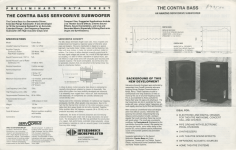
The Contrabass specs out to about 91dB 1/w one meter, a better efficiency than a bog-standard voice coil on a 15" driver with two 18" passive radiators, but not much. The wear rate on the belt mechanism was problematic, and the servo motors which were in common use for computer tape drives (IIRC) became very much more expensive, while high excursion drivers became ubiquitous.But would this be any more efficient than a bog-standard voice coil moving axially in a magnetic gap? Are there any other engineering advantages to the Danley approach? I don't have a clear vision about any of that yet.
At any rate, the passive radiator approach really is king for small/low/loud, though does use some watts.
That said, a Sunfire probably can produce more 30 Hz than an Ampeg SVT with a sealed 8x10", and would use no more average power given the fundamental/harmonic ratio of bass guitar.
A combination of something like the Sunfire with an 8" or 10" for 60-80 Hz up could be done in under 2 cubic foot.
If Bzzzt (Marty) or anyone is looking for the maximum output from a very small space and weight, the passive radiator, long excursion woofer for <60 Hz just can't be beat.
Art
Okay. You're definitely more artist than engineer, and you want to go with a completely off-the-wall concept. 🙂...We are making an instrument...
Look at the design of an upright bass - refined over several centuries of use. The most commonly used 3/4 size one has a 43.5" long body ( https://www.amromusic.com/bass-sizes ), and even with that enormous vibrating surface, it still doesn't pump out much of the fundamental frequency of the E string.
In a nutshell: if you want to make loud, low frequency sounds, the ideal solution is an enormous, yet very light, vibrating surface.
How do you make an enormous vibrating surface, and still have it light enough to carry? The first double bass was built in 1542, nearly five centuries ago, and the builder ( Silvestro Ganassi) used thin wood.
Today we have a material that's much lighter than wood, much cheaper than wood, and readily available in large sheets: Styrofoam (aka EPS, Expanded Polystyrene Sheet ). People tend to think of Styrofoam as trash, but actually it's a fascinating material with some very interesting mechanical properties.
Years ago, I built a loudspeaker enclosure from a Styrofoam beer-cooler, and I was surprised to find it sounded quite nice. There is a lot of internal damping in Styrofoam, so it wasn't boomy at all, but had an even tonal balance with a slightly bright sound.
diyAudio member extraordinaire Tubelab (George) has a similar story to tell: he also made a loudspeaker enclosure out of a Styrofoam container, but used a thicker-walled and sturdier one that was originally designed to be used as a shipping container for a large quantity of cellphones. He also liked the resulting sound.
A creative instrument maker from Flanders crafted a Styrofoam body for its lightness, to create a cello that was much louder (+6 dB) than traditional wooden cellos:
For years I've thought it would be fun to make an electric guitar amplifier in which the entire front was a vibrating sheet of Styrofoam. Ideally the voice coil would mount directly to it, and the magnet/spider assembly would be supported by being attached to the (wooden?) walls of the cab.
Even easier, the walls or back of the cab could be Styrofoam, with some wood structure along all the edges, and a wood panel on which to mount a conventional cone speaker. The Styrofoam walls would be driven by the air pressure in the box. This is more or less how I built my beer-cooler speaker, except mine had no wood edges - the only wood was a sheet of ply big enough to mount the speaker to.
As best I can tell, Leo's strength was taking other people's existing good ideas, incorporating them into his own products, and using his accountancy skills to stay in business through many lean years until his business took off.We are in Leo Fender territory here
Glad to help if I can - but keep in mind I have no woofer simulation software, and there are plenty of people on diyAudio who do, and those people can help you size a passive radiator better than I can.Would you be able to help with some maths that I can’t seem to get my head around, over pm. It’s to do with calculating the volume of the passive radiator that I need to make
-Gnobuddy
Thanks for that, it was hard to tell from what little information is still on the 'Web.Gnobuddy,
I don't think Tom's servo motors turned more than 360 degrees in any of the servo drive units.
My thought was, increase motor torque, decrease number of degrees of rotation. If the motor was designed with a coil that only pivoted back and forth through maybe 10 - 15 degrees, there would be no need for a belt, or brushes, or commutators. Instead, just slap a short lever on the coil, with a pushrod driving the speaker cone, like the setup James Watt invented to turn the motion of his steam engine pistons into rotary motion.
(Only in reverse, as this would be used to convert twisting motion at the motor coil into linear motion at the speaker cone.)
Watt's linkage had to have hinge points because of the large excursions and angles involved. To drive a speaker cone, excursions would be much smaller, so one might get away by simply using a slightly flexible pushrod (maybe made of Nylon or something similar).
This is what the OP on this thread was hoping to hear, I think. Unfortunately, I think we drove her away.At any rate, the passive radiator approach really is king for small/low/loud, though does use some watts.
-Gnobuddy
Hard drive "voice coil" actuator.just slap a short lever on the coil,
Quick, before SSDs kill the HD market.
Exactly like that! Except scaled up to be much torquier.Hard drive "voice coil" actuator.
I have a pile of hard drives removed from our computers as SSDs replaced them over the years, with data still on them. Been pondering drilling a hole through them and/or soaking them in a bucket of salt water for a few days before taking them to the recycling centre.
-Gnobuddy
More Styrofoam speakers:
Quite unsurprisingly, the largest ones have the best bass response. A full 8'x4' sheet of EPS foam might make a decent bass-guitar speaker.
-Gnobuddy
Quite unsurprisingly, the largest ones have the best bass response. A full 8'x4' sheet of EPS foam might make a decent bass-guitar speaker.
-Gnobuddy
My travel speakers are 4" x 4" bits of Corflute® with a similar driver. Not HiFi but usually way better than the clock radio / TV in the hotel room.More Styrofoam speakers:
I have a pile of hard drives
Yes, much is wrong for a speaker, but the parts is there. Interesting that the voice coil is 12 Ohms.
Amazing. Someone stole my idea, and yours, before we even had them, and put it all together, and posted it on You Tube, too!...the parts is there...
Considering there is no baffle, that sounds far better than I would have guessed. I didn't expect enough torque from that hard-drive actuator to produce that much low-frequency displacement in a speaker cone, even a small one with a soft surround.
And those are rare-earth magnets, too. Much stronger than most (Ferrite) speaker magnets. Maybe that's why there's that much torque.
-Gnobuddy
From one of the comments below that You Tube video:
Anyone know anything more?
-Gnobuddy
Google turns up nothing on "trirodial woofer". Dunno if that is a misspelling on Mr. Leimgruber's part. But the description sounds like a continuation of the old Tom Danley Contradrive Servobass doohickey.Chad Leimgruber said:...a lot of theaters that are using a👎 imax (IMAX) system use technology like this called trirodial woofers...and the(y')re good for really low range sounds (but) useless on anything above 40 Hz...
Anyone know anything more?
-Gnobuddy
From an interview with Brian Bonnick, Chief Technology Officer for IMAX ( https://www.homecinemachoice.com/content/sound-imax ):
The image attached below was found elsewhere on the 'Web. That is allegedly a single IMAX subwoofer, and those are 18-inch drivers.
By eyeball, that would make the cabinet at least 40"-42" wide, maybe 80"-84" tall. Not all that much smaller than an 8'x4' sheet of plywood (or Styrofoam).
-Gnobuddy
The interview also cites sustained passages at 118 dB SPL in some movie soundtracks.Brian Bonnick said:...Our minus 3dB point is 20Hz. Yeah, it is very low. The loudspeakers, both the sub-bass and the full-range systems, are custom-designed and manufactured by IMAX.
<snip>
(Our woofer drivers) ...have a big Xmax or linear travel, four drivers per cabinet, in custom-ported designs with up to eight cabinets, depending upon the size of the theatre. There is a substantial amount of sub-bass to provide full range when you need it. We make sure you have the horsepower.
The image attached below was found elsewhere on the 'Web. That is allegedly a single IMAX subwoofer, and those are 18-inch drivers.
By eyeball, that would make the cabinet at least 40"-42" wide, maybe 80"-84" tall. Not all that much smaller than an 8'x4' sheet of plywood (or Styrofoam).
-Gnobuddy
Attachments
sorry Gnobuddy that's the 3 way top cab of an IMax system and those are 12's
here's an an IMax sub

here's an an IMax sub
Attachments
Last edited:
Thanks. Can you add any details? Driver size? Box volume? Xmax? Driver Thiele/Small params?here's an an IMax sub
TIA,
-Gnobuddy
- Home
- Live Sound
- Instruments and Amps
- Passive radiator for bass guitar?
